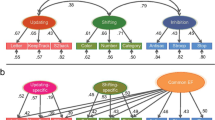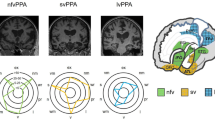Abstract
Objective
The aim of the study was to evaluate the sensitivity and reliability of assessing hemispheric language dominance with functional magnetic resonance imaging (fMRI) using a ‘free reversed association task.’
Methods
Thirty-nine healthy subjects (13 dextrals, 13 sinistrals and 13 bimanuals) underwent two repeated fMRI sessions. In the active phases sets of words were presented via headphones, and an associated target item was named. During the baseline phases a standard answer was given after listening to unintelligible stimuli. Data were preprocessed with SPM, and then laterality indices (LI) and reliability coefficients (RC) were calculated.
Results
Extensive frontal, temporal and parietal activations were found. Seventy-eight percent of the subjects showed left-hemispheric dominance, 5% showed right-hemispheric dominance, and 17% had bilateral language representations. The incidence of right-hemispheric language dominance was 4.3 times higher in a left-hander with a handedness quotient (HQ) of −90 than in a right-hander with a HQ of +90. The RC was 0.61 for combined ROIs (global network). Strong correlations were found between the two session LIs (r = 0.95 for the global network).
Conclusion
‘Free reversed association’ is a sensitive and reliable task for the determination of individual language lateralization. This suggests that the task may be used in a clinical setting.




Similar content being viewed by others
References
Binder JR, Swanson SJ, Hammeke TA, Morris GL, Mueller WM, Fischer M, Benbadis S, Frost JA, Rao SM, Haughton VM (1996) Determination of language dominance using functional MRI: a comparison with the Wada test. Neurology 46:978–984
Woermann FG, Jokeit H, Luerding R, Freitag H, Schulz R, Guertler S, Okujava M, Wolf P, Tuxhorn I, Ebner A (2003) Language lateralization by Wada test and fMRI in 100 patients with epilepsy. Neurology 61:699–701
Brannen JH, Badie B, Moritz CH, Quigley M, Meyerand ME, Haughton VM (2001) Reliability of functional MR imaging with word-generation tasks for mapping Broca’s area. AJNR Am J Neuroradiol 22:1711–1718
Rau S, Fesl G, Bruhns P, Havel P, Braun B, Tonn JC, Ilmberger J (2007) Reproducibility of activations in Broca area with two language tasks: a functional MR imaging study. AJNR Am J Neuroradiol 28:1346–1353
Fernandez G, Specht K, Weis S, Tendolkar I, Reuber M, Fell J, Klaver P, Ruhlmann J, Reul J, Elger CE (2003) Intrasubject reproducibility of presurgical language lateralization and mapping using fMRI. Neurology 60:969–975
Rutten GJ, Ramsey NF, van Rijen PC, van Veelen CW (2002) Reproducibility of fMRI-determined language lateralization in individual subjects. Brain Lang 80:421–437
Knecht S, Jansen A, Frank A, van Randenborgh J, Sommer J, Kanowski M, Heinze HJ (2003) How atypical is atypical language dominance? Neuroimage 18:917–927
Szaflarski JP, Binder JR, Possing ET, McKiernan KA, Ward BD, Hammeke TA (2002) Language lateralization in left-handed and ambidextrous people: fMRI data. Neurology 59:238–244
Lehericy S, Cohen L, Bazin B, Samson S, Giacomini E, Rougetet R, Hertz-Pannier L, Le Bihan D, Marsault C, Baulac M (2000) Functional MR evaluation of temporal and frontal language dominance compared with the Wada test. Neurology 54:1625–1633
Spreer J, Arnold S, Quiske A, Wohlfarth R, Ziyeh S, Altenmuller D, Herpers M, Kassubek J, Klisch J, Steinhoff BJ, Honegger J, Schulze-Bonhage A, Schumacher M (2002) Determination of hemisphere dominance for language: comparison of frontal and temporal fMRI activation with intracarotid amytal testing. Neuroradiology 44:467–474
Ramsey NF, Sommer IE, Rutten GJ, Kahn RS (2001) Combined analysis of language tasks in fMRI improves assessment of hemispheric dominance for language functions in individual subjects. Neuroimage 13:719–733
Gaillard WD, Balsamo L, Xu B, McKinney C, Papero PH, Weinstein S, Conry J, Pearl PL, Sachs B, Sato S, Vezina LG, Frattali C, Theodore WH (2004) fMRI language task panel improves determination of language dominance. Neurology 63:1403–1408
Gitelman DR, Nobre AC, Sonty S, Parrish TB, Mesulam MM (2005) Language network specializations: an analysis with parallel task designs and functional magnetic resonance imaging. Neuroimage 26:975–985
Deese J (1965) The structure of associations in language and thought. Johns Hopkins Press, Baltimore
Friederici AD, Alter K (2004) Lateralization of auditory language functions: a dynamic dual pathway model. Brain Lang 89:267–276
Scott SK (2005) Auditory processing - speech, space and auditory objects. Curr Opin Neurobiol 15:197–201
Scott SK, Wise RJ (2004) The functional neuroanatomy of prelexical processing in speech perception. Cognition 92:13–45
Hickok G, Poeppel D (2004) Dorsal and ventral streams: a framework for understanding aspects of the functional anatomy of language. Cognition 92:67–99
Ullman MT (2001) A neurocognitive perspective on language: the declarative/procedural model. Nat Rev Neurosci 2:717–726
Ullman MT (2004) Contributions of memory circuits to language: the declarative/procedural model. Cognition 92:231–270
Hagoort P, Hald L, Bastiaansen M, Petersson KM (2004) Integration of word meaning and world knowledge in language comprehension. Science 304:438–441
Jonides J, Lacey SC, Nee DE (2005) Processes of Working Memory in Mind and Brain. Current Directions in Psychological Science 14:2–5
Shivde G, Thompson-Schill SL (2004) Dissociating semantic and phonological maintenance using fMRI. Cogn Affect Behav Neurosci 4:10–19
Catani M, Jones DK, ffytche DH (2005) Perisylvian language networks of the human brain. Ann Neurol 57:8–16
Devlin JT, Moore CJ, Mummery CJ, Gorno-Tempini ML, Phillips JA, Noppeney U, Frackowiak RS, Friston KJ, Price CJ (2002) Anatomic constraints on cognitive theories of category specificity. Neuroimage 15:675–685
Thompson-Schill SL, Bedny M, Goldberg RF (2005) The frontal lobes and the regulation of mental activity. Curr Opin Neurobiol 15:219–224
Knecht S, Drager B, Deppe M, Bobe L, Lohmann H, Floel A, Ringelstein EB, Henningsen H (2000) Handedness and hemispheric language dominance in healthy humans. Brain 123(Pt 12):2512–2518
Desmond JE, Sum JM, Wagner AD, Demb JB, Shear PK, Glover GH, Gabrieli JD, Morrell MJ (1995) Functional MRI measurement of language lateralization in Wada-tested patients. Brain 118(Pt 6):1411–1419
Bahn MM, Lin W, Silbergeld DL, Miller JW, Kuppusamy K, Cook RJ, Hammer G, Wetzel R, Cross D 3rd (1997) Localization of language cortices by functional MR imaging compared with intracarotid amobarbital hemispheric sedation. AJR Am J Roentgenol 169:575–579
Yetkin FZ, Swanson S, Fischer M, Akansel G, Morris G, Mueller W, Haughton V (1998) Functional MR of frontal lobe activation: comparison with Wada language results. AJNR Am J Neuroradiol 19:1095–1098
Carpentier A, Pugh KR, Westerveld M, Studholme C, Skrinjar O, Thompson JL, Spencer DD, Constable RT (2001) Functional MRI of language processing: dependence on input modality and temporal lobe epilepsy. Epilepsia 42:1241–1254
Rutten GJ, Ramsey NF, van Rijen PC, Alpherts WC, van Veelen CW (2002) FMRI-determined language lateralization in patients with unilateral or mixed language dominance according to the Wada test. Neuroimage 17:447–460
Sabbah P, Chassoux F, Leveque C, Landre E, Baudoin-Chial S, Devaux B, Mann M, Godon-Hardy S, Nioche C, Ait-Ameur A, Sarrazin JL, Chodkiewicz JP, Cordoliani YS (2003) Functional MR imaging in assessment of language dominance in epileptic patients. Neuroimage 18:460–467
Springer JA, Binder JR, Hammeke TA, Swanson SJ, Frost JA, Bellgowan PS, Brewer CC, Perry HM, Morris GL, Mueller WM (1999) Language dominance in neurologically normal and epilepsy subjects: a functional MRI study. Brain 122(Pt 11):2033–2046
Oldfield RC (1971) The assessment and analysis of handedness: the Edinburgh inventory. Neuropsychologia 9:97–113
Barnett KJ, Corballis MC (2002) Ambidexterity and magical ideation. Laterality 7:75–84
Corey DM, Hurley MM, Foundas AL (2001) Right and left handedness defined: a multivariate approach using hand preference and hand performance measures. Neuropsychiatry Neuropsychol Behav Neurol 14:144–152
Huang J, Carr TH, Cao Y (2002) Comparing cortical activations for silent and overt speech using event-related fMRI. Hum Brain Mapp 15:39–53
Talairach J, Tournoux P (1988) Co-planar stereotactic atlas of the human brain. Thieme, New York
Friston KJ, Ashburner J, Poline JB, Frith CD, Heather JD, Frackowiak RSJ (1995) Spatial registration and normalisation of images. Hum Brain Mapp 2:165–189
Poline JB, Worsley KJ, Holmes AP, Frackowiak RS, Friston KJ (1995) Estimating smoothness in statistical parametric maps: variability of p values. J Comput Assist Tomogr 19:788–796
Friston KJ, Holmes AP, Worsley KJ, Poline JB, Frith CD, Frackowiak RS (1995) Statistical parametric maps in functional imaging: a general linear approach. Hum Brain Mapp 2:189–210
Tzourio-Mazoyer N, Landeau B, Papathanassiou D, Crivello F, Etard O, Delcroix N, Mazoyer B, Joliot M (2002) Automated anatomical labeling of activations in SPM using a macroscopic anatomical parcellation of the MNI MRI single-subject brain. Neuroimage 15:273–289
Demonet JF, Thierry G, Cardebat D (2005) Renewal of the neurophysiology of language: functional neuroimaging. Physiol Rev 85:49–95
Rombouts SA, Barkhof F, Hoogenraad FG, Sprenger M, Valk J, Scheltens P (1997) Test-retest analysis with functional MR of the activated area in the human visual cortex. AJNR Am J Neuroradiol 18:1317–1322
Liegeois F, Connelly A, Salmond CH, Gadian DG, Vargha-Khadem F, Baldeweg T (2002) A direct test for lateralization of language activation using fMRI: comparison with invasive assessments in children with epilepsy. Neuroimage 17:1861–1867
Nagata SI, Uchimura K, Hirakawa W, Kuratsu JI (2001) Method for quantitatively evaluating the lateralization of linguistic function using functional MR imaging. AJNR Am J Neuroradiol 22:985–991
Scott SK, Blank CC, Rosen S, Wise RJ (2000) Identification of a pathway for intelligible speech in the left temporal lobe. Brain 123 Pt 12:2400–2406
Crottaz-Herbette S, Anagnoson RT, Menon V (2004) Modality effects in verbal working memory: differential prefrontal and parietal responses to auditory and visual stimuli. Neuroimage 21:340–351
Indefrey P, Levelt WJ (2004) The spatial and temporal signatures of word production components. Cognition 92:101–144
Shuster LI, Lemieux SK (2005) An fMRI investigation of covertly and overtly produced mono- and multisyllabic words. Brain Lang 93:20–31
Duffau H, Capelle L, Denvil D, Gatignol P, Sichez N, Lopes M, Sichez JP, Van Effenterre R (2003) The role of dominant premotor cortex in language: a study using intraoperative functional mapping in awake patients. Neuroimage 20:1903–1914
Ackermann H, Riecker A (2004) The contribution of the insula to motor aspects of speech production: a review and a hypothesis. Brain Lang 89:320–328
Rasmussen T, Milner B (1977) The role of early left-brain injury in determining lateralization of cerebral speech functions. Ann N Y Acad Sci 299:355–369
Risse GL, Gates JR, Fangman MC (1997) A reconsideration of bilateral language representation based on the intracarotid amobarbital procedure. Brain Cogn 33:118–132
Pujol J, Deus J, Losilla JM, Capdevila A (1999) Cerebral lateralization of language in normal left-handed people studied by functional MRI. Neurology 52:1038–1043
Kloppel S, Buchel C (2005) Alternatives to the Wada test: a critical view of functional magnetic resonance imaging in preoperative use. Curr Opin Neurol 18:418–423
Powell HR, Duncan JS (2005) Functional magnetic resonance imaging for assessment of language and memory in clinical practice: review. Curr Opin Neurol 18:161–166
Acknowledgement
This research was supported by the “Förderprogramm für Forschung und Lehre der LMU-München“(Reg. No. 332), University of Munich, Germany. We are grateful to Virginia Flanagin for critically reading the manuscript.
Author information
Authors and Affiliations
Corresponding author
Rights and permissions
About this article
Cite this article
Fesl, G., Bruhns, P., Rau, S. et al. Sensitivity and reliability of language laterality assessment with a free reversed association task—a fMRI study. Eur Radiol 20, 683–695 (2010). https://doi.org/10.1007/s00330-009-1602-4
Received:
Revised:
Accepted:
Published:
Issue Date:
DOI: https://doi.org/10.1007/s00330-009-1602-4




